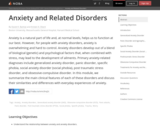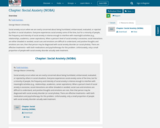
Text and links to all ancillary materials for Module 39
- Subject:
- Psychology
- Social and Behavioral Sciences
- Material Type:
- Module
- Reading
- Teaching/Learning Strategy
- Author:
- David H
- Kristen K
- Date Added:
- 05/31/2021

Text and links to all ancillary materials for Module 39

By Todd Kashdan, George Mason University. Social anxiety occurs when we are overly concerned about being humiliated, embarrassed, evaluated, or rejected by others in social situations. Everyone experiences social anxiety some of the time, but for a minority of people, the frequency and intensity of social anxiety is intense enough to interfere with meaningful activities (e.g., relationships, academics, career aspirations). When a person’s level of social anxiety is excessive, social interactions are either dreaded or avoided, social cues and emotions are difficult to understand, and positive thoughts and emotions are rare, then that person may be diagnosed with social anxiety disorder (or social phobia). There are effective treatments—with both medications and psychotherapy–for this problem. Unfortunately, only a small proportion of people with social anxiety disorder actually seek treatment.

Introduction to Sociology 2e adheres to the scope and sequence of a typical, one-semester introductory sociology course. It offers comprehensive coverage of core concepts, foundational scholars, and emerging theories, which are supported by a wealth of engaging learning materials. The textbook presents detailed section reviews with rich questions, discussions that help students apply their knowledge, and features that draw learners into the discipline in meaningful ways. The second edition retains the book’s conceptual organization, aligning to most courses, and has been significantly updated to reflect the latest research and provide examples most relevant to today’s students. In order to help instructors transition to the revised version, the 2e changes are described within the preface.


Understand how social epidemiology can be applied to health in the United StatesExplain disparities of health based on gender, socioeconomic status, race, and ethnicityGive an overview of mental health and disability issues in the United StatesExplain the terms stigma and medicalization

A brief introduction about characteristics of the anxiety disorders in general, and specific types: specific phobia, agoraphobia, social anxiety disorder, panic disorder, generalized anxiety disorder
Duration: 4:35.